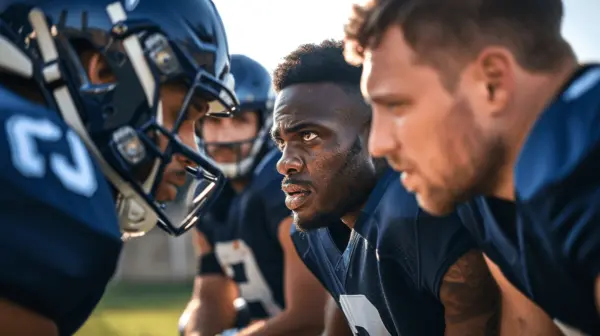Welcome to the playbook of champions! In the fast-paced world of sports, where every move counts, leadership emerges as the game-changer. This page is your front-row ticket to understanding why leadership is not just a buzzword but a crucial aspect of an athlete’s journey.
Leadership
Defining Athletic Leadership:
In the realm of sports, leadership is not about bossing people around or shouting orders. It’s about inspiring and influencing teammates towards a common goal. Think of it as the glue that binds a team together. An athletic leader is the heartbeat of the squad, setting the rhythm for success.
Fostering Team Cohesion:
A cohesive team is like a well-oiled machine – smooth, efficient, and unstoppable. A true leader knows how to build bridges, not walls. They understand the strengths and weaknesses of each teammate, fostering an environment where collaboration thrives. Team cohesion is the secret sauce that transforms a group of individuals into a powerhouse.
Leading by Example:
Actions speak louder than words, especially in the sports arena. A leader isn’t the one who talks the talk but the one who walks the walk. From punctuality to perseverance, leading by example cultivates a culture of discipline and dedication. Remember, a team reflects its leader.
Motivational Techniques:
Ever wonder what makes athletes push their limits even when the odds seem insurmountable? That’s the magic of motivation. A skilled leader knows how to ignite the fire within each team member. Whether it’s a pep talk, setting achievable goals, or a simple pat on the back, motivation is the fuel that propels teams to victory.
Navigating Challenges:
Sports are a rollercoaster of triumphs and setbacks. A true leader doesn’t shy away from challenges; they thrive on them. Navigating through tough times requires resilience, strategic thinking, and the ability to keep a cool head. The leader becomes the anchor when storms hit, ensuring the team sails through unscathed.

Developing Leadership Skills:
Leadership is not a static trait but a skill that can be honed and polished. Developing leadership skills involves constant self-reflection, learning from experiences, and embracing feedback. It’s a journey, not a destination. Every athlete possesses the potential to become a leader; they just need to unlock it.
Real Leadership Stories: The Jorge Costa Chronicle
In the illustrious world of football, few tales resonate with the essence of leadership like that of Jorge Costa. This real-life leadership anecdote, narrated by none other than the “Special One” himself, Jose Mourinho, sheds light on the profound impact a true leader can have on a team’s fate.
The Turning Point: Belenenses Battle
In a candid interview back in 2019, Mourinho recounted a pivotal moment during his coaching stint where Porto, under his tutelage, faced a daunting 2-0 halftime deficit against Belenenses. Frustration and tension hung in the air as Mourinho headed towards the dressing room, visibly fuming.
Jorge Costa Takes Command:
Amidst the palpable tension, Jorge Costa, a key player in Mourinho’s squad and a natural-born leader, approached him with a request: “Wait outside two minutes, please.” Intrigued, Mourinho obliged as Costa entered the dressing room alone, closing the door behind him.
The Dirty Job:
Behind closed doors, Jorge Costa assumed the mantle of leadership. He took charge, rallying the team, delivering the pep talk, and instilling the belief that a comeback was not only possible but inevitable. In those two minutes, Costa did the ‘dirty job’ – the gritty, motivational work that would set the stage for a remarkable turnaround.
The Unveiling:
As the door swung open, Costa ushered Mourinho back into the dressing room and uttered just two words: “Coach us.” He had laid the groundwork for victory, executing every move that Mourinho would have orchestrated. Costa’s astute understanding of his teammates, coupled with his ability to inspire and organize, turned the tide in Porto’s favour.
The Triumph:
What followed was nothing short of magical. Porto, fuelled by Costa’s impromptu leadership, clinched a sensational 3-2 victory. The comeback was not just a testament to the team’s skill but a glaring example of how a leader, in the absence of their coach, could single-handedly orchestrate success.

The Legacy of Jorge Costa:
Jorge Costa’s leadership during that Belenenses battle isn’t just a chapter in Porto’s history; it’s a masterclass in leadership. It exemplifies the selfless commitment of a player to the collective cause, the ability to step up when the team needs it most, and the strategic acumen to navigate challenges.
In sports folklore, the tale of Jorge Costa stands as a beacon, illuminating the transformative power of leadership in the crucible of competition. Aspiring athletes, take note – sometimes, the most remarkable leaders emerge in the heat of the battle, ready to do the ‘dirty job’ for the collective triumph.
A good leader possesses the following qualities:
- Integrity: A good leader is honest and adheres to strong moral principles.
- Communication: Effective communication skills are essential for a leader to convey ideas and listen to team members.
- Empathy: Understanding and sharing the feelings of others helps build strong relationships.
- Accountability: Taking responsibility for their actions and decisions is crucial for a leader.
- Vision: A leader should have a clear vision and the ability to inspire others to follow it.
How do you define a good leader?
A good leader is someone who inspires and motivates others, demonstrates integrity, and leads by example. They communicate effectively, make informed decisions, and create a positive environment where team members can thrive.
What is leadership in 3 words?
Vision, Influence, Empathy.
What defines a bad leader?
A bad leader often exhibits poor communication skills, lacks empathy, avoids responsibility, and fails to inspire or motivate their team. They may also show favoritism, make decisions based on personal gain, and ignore the contributions of others.
What are the big five traits of a leader?
The big five traits of a leader are:
- Openness: Willingness to consider new ideas and experiences.
- Conscientiousness: Being organized, dependable, and disciplined.
- Extraversion: Being outgoing, energetic, and assertive.
- Agreeableness: Being cooperative, compassionate, and friendly.
- Emotional Stability: Remaining calm and composed under pressure.
What are the 7 habits of leadership?
The 7 habits of leadership are:
- Be Proactive: Take initiative and responsibility for your actions.
- Begin with the End in Mind: Have a clear vision of your goals.
- Put First Things First: Prioritize tasks based on importance.
- Think Win-Win: Seek mutually beneficial solutions.
- Seek First to Understand, Then to Be Understood: Practice empathetic listening.
- Synergize: Collaborate effectively with others.
- Sharpen the Saw: Continuously improve and renew your skills and knowledge.
What are the 5 R’s of leadership?
The 5 R’s of leadership are:
- Respect: Valuing others and fostering a culture of mutual respect.
- Responsibility: Being accountable for your actions and decisions.
- Resilience: Bouncing back from setbacks and persevering through challenges.
- Reflection: Regularly evaluating your performance and seeking improvement.
- Relationships: Building strong, trusting relationships with team members and stakeholders.
What does a weak leader look like?
A weak leader often lacks confidence, fails to make decisions, and avoids taking responsibility. They may struggle with communication, show inconsistency in their actions, and have difficulty inspiring or motivating their team.
What defines a toxic leader?
A toxic leader is characterized by manipulative behavior, a lack of empathy, and a focus on their own interests over those of the team. They may use fear and intimidation to control others, create a hostile work environment, and undermine the morale and productivity of their team members.